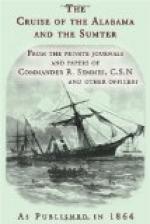Such was the Alabama, or, as she was long called, “No. 290;” and considering the peculiar circumstances under which she was built, the numerous requirements to be satisfied, and the perfection of the workmanship throughout the vessel, the cost of her construction and armament cannot but be considered marvellously small. The builder’s charge for hull, spars, sails, boats, cable, and all equipment, except armament, was L47,500. To this must be added the cost of her batteries, L2500; magazine tanks, L616; ordnance stores, L500; and small arms, L600, making a-total cost of L51,716, or in American money, of 250,305.44 dollars.
It must not be supposed, however, that in leaving the building-yard of Messrs. Laird, the Alabama’s equipment was by any means complete. The strictest injunctions had been given both to Captain Bullock and Captain Semmes, to avoid doing anything that would by any possibility be construed into an infringement of either the municipal law, or the anxiously-guarded neutrality of England; and as the Foreign Enlistment Act clearly forbade the equipment of ships of war for belligerent uses, it was necessary that the new cruiser should leave England unarmed, and take her chance of capture, until some safe place could be found for taking her armament on board.
This was, of course, a delicate operation, and one requiring the preservation of strict secresy, that the cruisers of the United States might at least not be enabled to pounce upon their new enemy, until she had been placed to some extent in a condition for self-defence. Nor was this the only ground on which caution had to be observed. The career of the Sumter had given Captain Semmes a clearer idea than he had probably before possessed of the precise meaning of the word neutrality, as applied to the present war, and there was too much at stake to run the risk of detention from any such views of its obligations as had been put forward in the case of his captive officer at Tangier. The law of the case might be—he certainly thought it was—clear enough; but there was no use in throwing temptation in the way of those by whom it was to be interpreted. The recent cases of the Alexandria, the El Tousson, and the El Monassir, have shown with sufficient clearness that this calculation was tolerably correct.




